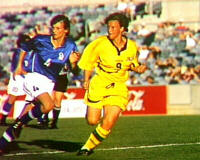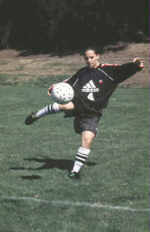 | ||
 |
||
|
| ||
 |
|||||||||||||||||||||||||||||||||||||||
Soccer Characteristics of the Sport Soccer matches consist of two 45 minute halves with a short break between halves. Soccer characteristically involves high-intensity intermittent exercise which utilises both aerobic and anaerobic energy systems. Training The Australian soccer scene now sees year-round play, with the National League being conducted over the summer months and State/club competition continuing as winter sports. At lower levels of competition, players may have extensive off-season lay-offs causing body fat levels to be considerably higher at the beginning of the following season. Pre-season training typically involves general conditioning work, weight training and skill practice. During the season, two to four training sessions are generally scheduled between matches. Competition For most soccer teams, the competitive season involves a weekly match played during the day on weekends, or in the evening mid-week. At the elite level, extensive travel is usually required and some double-fixtures may be scheduled. Tournaments of one to several weeks may also be played in addition to regular competition. Soccer is a fast game of intensive play with light activity between bursts. While tackling rules are strict, significant body contact occurs with the potential for contact injuries. Time-motion studies of soccer have determined that the average national and international player covers about ten kilometers in a match. Goal keepers typically cover about four kilometres. Soccer matches challenge fuel and fluid stores. 1-2kg fluid losses have been reported during standard soccer matches. Losses may be double this during humid conditions. Physical Characteristics Soccer players must be skilled, agile and fast. Players vary widely in body size however, most players tend to be well-muscled with a low body fat level to maximise speed and agility. Common Nutrition Issues Body Fat Levels It is important for soccer players to be aware of seasonal changes in energy requirements. For year-round weight control, it may be necessary for players to reduce food intake to match the decrease in training output during the off-season. Alternatively, players may choose to take up some activity to give them a head-start next season. The Training Diet – Week-round Recovery Soccer players require a high carbohydrate intake on a daily basis to replenish muscle stores after each training session. On average, players will require between 5-8 grams of carbohydrate per kilogram each day. This requires making carbohydrate foods such as bread, breakfast cereal, fruit, pasta, rice, vegetables, yoghurt and flavoured low-fat milk the focus of meals and snacks. Players who fail to consume sufficient carbohydrate may suffer mid-week slumps and progressive fatigue over the season. Players in heavy training need to start recovery nutrition tactics immediately after each training session. Ideally, players should aim to have 50-100 grams of carbohydrate within 30 minutes of finishing training. Recovery snacks should be combined with fluid to replace any fluid lost during the session.
Match Preparation Ideally, a light, high-carbohydrate meal should be eaten at least two hours before a match. Breakfast cereal plus fruit, pasta with tomato sauce, rolls or sandwiches, baked potatoes with low fat fillings and fruit salad with yoghurt are all good options. Experiment to find the best one for you. Many clubs like to organise the pre-event meal as a team activity, especially when they travel to an 'away' game. Eating together can be a good way to raise team morale and get focussed on the match, as well as making sure that all players are well-fuelled. Match Considerations - Fuel and Fluid Soccer matches place reasonable demands on both fluid and carbohydrate stores of players. Studies have reported low muscle glycogen levels in players after a match- sometimes with significant depletion occurring by half-time. Players with depleted muscle glycogen stores had a lower average speed and covered less ground than their team-mates in the second half of the match. Studies show that strategies to increase carbohydrate supplies - both eating a high carbohydrate diet in the days before a match and drinking sports drink during the match, keep players running faster and further in the second half. In one study, high carbohydrate tactics helped the players to make less errors. Sweat losses of 1-2.5 litres per 90 minute game in cool conditions and approximately 4 litres during hot conditions have been reported in some studies. However, the reported fluid intake of players wis typically less than half of the sweat rate. We have been interested to monitor fluid losses and drinking patterns of AIS soccer players in training and in matches; in a variety of weather conditions. We found considerable variation between sweat rates and drinking rates of individual players - some drank well, but many needed encouragement. It has been suggested that fluid intake during competition is limited by the rules of the game, which only allow players to drink at half-time when they leave the pitch. However, our results show that players also become dehydrated at training sessions when these rules don't apply.
Tips for better drinking during soccer are:
Post-match Recovery A team approach to recovery is the best way to ensure all players replace fuel and fluid immediately after matches. Organise to have suitable drinks and snacks available after the match as a team activity so that everyone can enjoy the benefits. A postmatch spread of sandwiches, fruit, soup and carbohydrate drinks in the club, or a box of supplies in the bus on the way back from 'away' matches can get recovery off to a good start. Alcohol Intake There is a tendency in team sports to celebrate or commiserate match results with alcohol intake - and unfortunately this often means excessive amounts of alcohol. The decision to drink alcohol is the personal right of each athlete. Sensible use of alcohol does not impair health or performance however, alcohol intake can interfere with post-exercise recovery. Alcohol acts a diuretic and may slow down the process of rehydration after the match. Despite what you may have heard about beer and carbo-loading, alcoholic drinks are low in carbohydrate content and will not fuel up your muscle glycogen stores. After exercise, the soccer player should concentrate first on rehydration and refuelling goals. Rehydrate and refuel with carbohydrate-rich foods and fluids before having any alcoholic drinks. Then set yourself a limit and be aware of how much you have consumed. Avoid any alcohol for 24 hours post exercise if any soft-tissue injures or bruising have occurred. The injured athlete who consumes alcohol immediately after the match may cause extra swelling and bleeding and delay recovery. Case Study 1 Question – I am used to playing soccer in the morning but have now moved into the senior league where my matches are at 3:00pm. What should I eat before matches? Some of the older players swear by bacon and eggs. Others say I should stick to the honey toast and fruit juice that I am used to having. The goals of the pre-match meal are to:
There are plenty of meal combinations which can achieve these goals but players need to experiment to find the best combination for them. Generally, the following is recommended:
Some players may eat low-carbohydrate, high-fat meals such as bacon and eggs and oily lasagnes with no ill-effects. These meals are certainly not ideal but some players appear to get away with it. The psychological effect of the last meal can be as important as the nutritional effects for some players. However, for the majority of players, a high carbohydrate meal is the best option. All players need to experiment to find the best food choices and timing for them. Case Study 2As the Matilda's build up to the Sydney Olympics intensified, the coach approached the AIS nutrition department for some advice on using creatine. He was looking to give an extra edge to his players and wondered if creatine may help. The dietitians weighed up the information available on creatine. Numerous studies have demonstrated that creatine can benefit repeated high-intensity exercise bouts broken up by short recovery periods and soccer certainly involves this type of activity. However, most studies have been undertaken in laboratories using testing protocols very different from on field activity patterns. Also most studies had used male subjects. While many studies suggested that creatine had the potential to benefit soccer players, there was little direct evidence to show that creatine would benefit the Matildas. Most studies demonstrated some weight gain as a result of taking creatine and it was possible that this may actually impair the speed and agilty of the Matildas. The dietitians were satisfied that the Matildas were already following good nutritional and training practices. They decided it would be worth doing a trial to see if creatine could provide some additional benefit. A testing protocol was designed which mimicked the Matilda's on-field activity. A double-blind design was used where some players were supplemented with creatine and others were given a placebo. None of the players knew whether they were receiving creatine or placebo. The trial showed that despite gaining weight, players taking creatine improved their performance of some repeated sprint and agility tests. As a result of the trial, it was decided to continue to supplement the Matildas with creatine. Players are assessed regularly by AIS dietitians. Only players who demonstrate good nutritional practices are considered candidates for supplementation. Greater gains can be obtained by maximising nutritional and training practices than by using creatine. However, once all other aspects of the players preparation is taken care of, creatine may provide additional benefits. See the Supplement and Research sections of the website for more information on creatine.
You will find more information about soccer at the
Australian Institute of Sport on the
|
| ||||||||||||||||||||||||||||||||||||||
|
The Department of Sports Nutrition is a program of the
Australian Institute of Sport General enquires can be emailed to: aisnutrition@ausport.gov.au Copyright
© Australian Sports Commission
| |||||||||||||||||||||||||||||||||||||||








